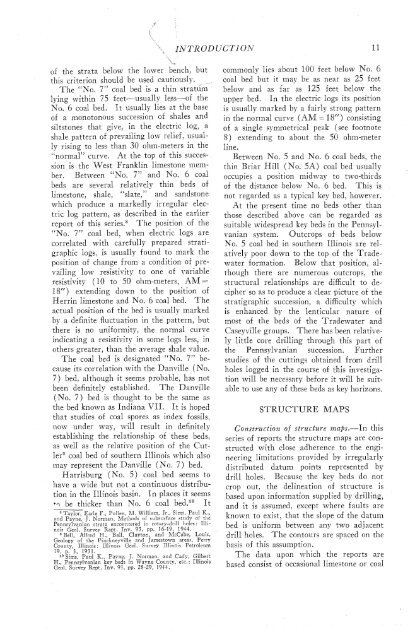subsurface geology and coal resources of the pennsylvanian system ...
subsurface geology and coal resources of the pennsylvanian system ...
subsurface geology and coal resources of the pennsylvanian system ...
Create successful ePaper yourself
Turn your PDF publications into a flip-book with our unique Google optimized e-Paper software.
oi <strong>the</strong> strata below <strong>the</strong> lower bench, but<br />
this criterion should be used cautiously. -<br />
The "No. 7" <strong>coal</strong> bed is a thin stratum<br />
lying within 75 feet-usually less-<strong>of</strong> <strong>the</strong><br />
No. 6 <strong>coal</strong> bed. It usually lies at <strong>the</strong> base<br />
<strong>of</strong> a monotonous succession <strong>of</strong> shales <strong>and</strong><br />
siltstones that give, in <strong>the</strong> electric log, a<br />
shale pattern <strong>of</strong> prevailing low relief, usually<br />
rising to less than 30 ohm-meters in <strong>the</strong><br />
"normal" curve. At <strong>the</strong> top <strong>of</strong> this succession<br />
is <strong>the</strong> West Franklin limestone member.<br />
Between "No. 7" <strong>and</strong> No. 6 <strong>coal</strong><br />
beds are several relatively thin beds <strong>of</strong><br />
limestone, shale, "slate," <strong>and</strong> s<strong>and</strong>stone<br />
which produce a markedly irregular electric<br />
log pattern, as described in <strong>the</strong> earlier<br />
report <strong>of</strong> this serie~.~ The position <strong>of</strong> <strong>the</strong><br />
"No. 7" <strong>coal</strong> bed, when electric logs are<br />
correlated with carefully prepared stratigraphic<br />
logs, is usually found to mark <strong>the</strong><br />
position <strong>of</strong> change from a condition <strong>of</strong> prevailing<br />
low resistivity to one <strong>of</strong> variable<br />
resistivity (10 to 50 ohm-meters, AM =<br />
18") extending down to <strong>the</strong> position <strong>of</strong><br />
Herrin limestone <strong>and</strong> No. 6 <strong>coal</strong> bed. The<br />
actual position <strong>of</strong> <strong>the</strong> bed is usually marked<br />
by a definite fluctuation in <strong>the</strong> pattern, but<br />
<strong>the</strong>re is no uniformity, <strong>the</strong> normal curve<br />
indicating a resistivity in some logs less, in<br />
o<strong>the</strong>rs greater, than <strong>the</strong> average shale value.<br />
The <strong>coal</strong> bed is designated "No. 7" because<br />
its correlation with <strong>the</strong> Danville (No.<br />
'7) bed, although it seems probable, has not<br />
been definitely established. The Danville<br />
(No. 7) bed is thought to be <strong>the</strong> same as<br />
<strong>the</strong> bed known as Indiana VII. It is hoped<br />
that studies <strong>of</strong> <strong>coal</strong> spores as index fossils,<br />
now under way, will result in definitely<br />
establishing <strong>the</strong> relationship <strong>of</strong> <strong>the</strong>se beds,<br />
as well as <strong>the</strong> relative position od <strong>the</strong> CutlerQoal<br />
bed <strong>of</strong> sou<strong>the</strong>rn Illinois which also<br />
may represent <strong>the</strong> Danville (No. 7) bed.<br />
Harrisburg (No. 5) <strong>coal</strong> bed seems to<br />
-<br />
have a wide but not a continuous distribution<br />
in <strong>the</strong> Illinois basin. In places it seems<br />
t~ be thicker than No. 6 <strong>coal</strong> bed.1° It<br />
Taylor, Earle F., Pullen, At. William, Jr., Sims, Paul K.,<br />
<strong>and</strong> Pavne, J. Norman, Methods <strong>of</strong> <strong>subsurface</strong> study <strong>of</strong> <strong>the</strong><br />
Pennsyfvanian strata encountered in rotary-drill holes: Illi-<br />
nois Geol. Survey Rept. Inv. 93, pp. 16-19, 1944.<br />
"ell, Alfred H., Ball. Clayton, <strong>and</strong> McCabe, Louis,<br />
Geology <strong>of</strong> .<strong>the</strong> Pinckneyville <strong>and</strong> Jamestown areaq, Perry<br />
Countv. Illmo~s: Illinois Geol. Survey Illinois Petroleum<br />
19, p..'3, 1931.<br />
10 Sims Paul I(.. Payne, J. Norman. <strong>and</strong> Cady, Gilbert<br />
H., ~enni~lvanian key beds in Wayne County, etc.: Illinois<br />
Geol. Survey Rept. Inv. 93, pp. 28-29, 1944.<br />
commonly lies about 100 feet below No. 6<br />
<strong>coal</strong> bed but it may be as near as 25 feet<br />
below <strong>and</strong> as far as 125 feet below <strong>the</strong><br />
upper bed.<br />
In <strong>the</strong> electric logs its ~osition<br />
is usually marked by a fairly strong pattern<br />
in <strong>the</strong> normal curve (AM = 18") consisting<br />
<strong>of</strong> a single symmetrical peak (see footnote<br />
8) extending to about <strong>the</strong> 50 ohm-meter<br />
line.<br />
Between No. 5 <strong>and</strong> No. 6 <strong>coal</strong> beds, <strong>the</strong><br />
thin Briar Hill (No. 5A) <strong>coal</strong> bed usually<br />
occupies a position midway to two-thirds<br />
<strong>of</strong> <strong>the</strong> distance below No. 6 bed. This is<br />
not regarded as a typical key bed, however.<br />
At <strong>the</strong> present time no beds o<strong>the</strong>r than<br />
those described above can be regarded as<br />
suitable widespread key beds in <strong>the</strong> Pennsyl-<br />
vanian <strong>system</strong>. Outcrops <strong>of</strong> beds below<br />
No. 5 <strong>coal</strong> bed in sou<strong>the</strong>rn Illinois are relatively<br />
poor down to <strong>the</strong> top <strong>of</strong> <strong>the</strong> Tradewater<br />
formation. Below that position, although<br />
<strong>the</strong>re are numerous outcrops, <strong>the</strong><br />
structural relationships are difficult to decipher<br />
so as to produce a clear picture <strong>of</strong> <strong>the</strong><br />
stratigraphic succession, a difficulty which<br />
is enhanced ~ J J <strong>the</strong> lenticular nature <strong>of</strong><br />
most <strong>of</strong> <strong>the</strong> beds <strong>of</strong> <strong>the</strong> Tradewater <strong>and</strong><br />
Caseyville groups. There has been relatively<br />
little core drilling through this part <strong>of</strong><br />
<strong>the</strong> Pennsylvanian succession. Fur<strong>the</strong>r<br />
studies <strong>of</strong> <strong>the</strong> cuttings obtained from drill<br />
holes logged in <strong>the</strong> course <strong>of</strong> this investigation<br />
will be necessary before it will be suitable<br />
to use any <strong>of</strong> <strong>the</strong>se beds as key horizons.<br />
STRUCTURE MAPS<br />
Construction <strong>of</strong> structure nznps.-In this<br />
series <strong>of</strong> reports <strong>the</strong> structure maps are constructed<br />
with close adherence to <strong>the</strong> engineering<br />
limitations provided by irregularly<br />
distributed datum points represented by<br />
drill holes, Because <strong>the</strong> key beds do not<br />
crop out, <strong>the</strong> delineation <strong>of</strong> structure is<br />
based upon information supplied by drilling,<br />
<strong>and</strong> it is assumed, except where faults are<br />
known to exist, that <strong>the</strong> slope <strong>of</strong> <strong>the</strong> datum<br />
bed is uniform between any two adjacent<br />
drill holes. The contours are spaced on <strong>the</strong><br />
basis <strong>of</strong> this assumption.<br />
The data upon v:hich <strong>the</strong> reports are<br />
based consist <strong>of</strong> occasional limestone or <strong>coal</strong>
















